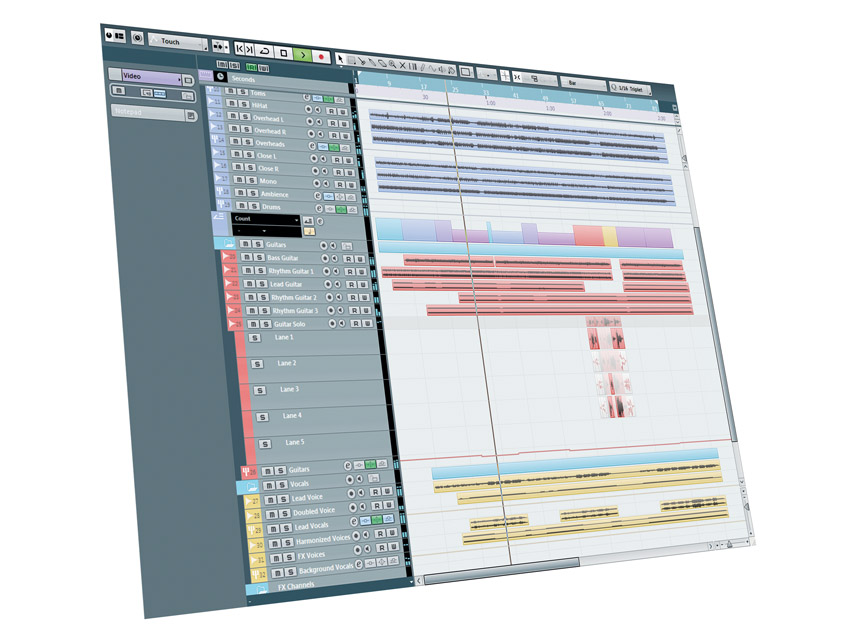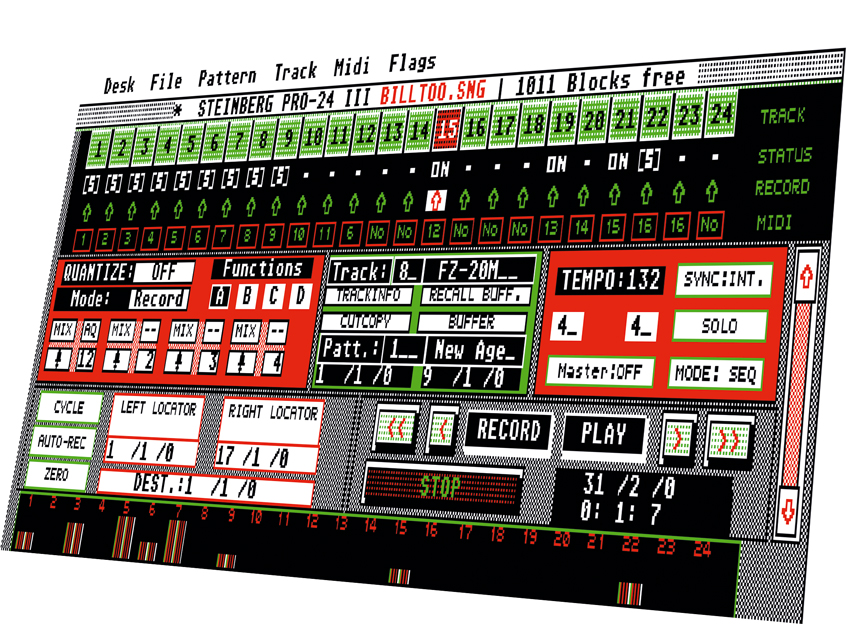A brief history of Steinberg Cubase
We check out the family tree of the legendary DAW

Cubase 6

Pro-24
The story of Cubase bears a striking resemblance in parts to that of Logic. From their roots on the Commodore 64, both applications developed into highly sophisticated DAWs.
Here, we'll find out how Cubase helped Steinberg Media Technologies grow from humble beginnings to become one of the biggest music software companies of the 21st century.
Pro 16 tools?
Steinberg Research arrived on the scene in 1984, in the era when the Commodore 64 dominated a miniscule computer music scene.
The company, formed by Karl 'Charlie' Steinberg and Manfred Rürup, offered just one product: a basic 16-track MIDI sequencer package named Multitrack Recorder.
Rürup, a keyboard player, and Steinberg, a musician and studio engineer, were some of the earliest adopters of the relatively new MIDI protocol, immediately spotting its potential for computer sequencing.
"VST was the first plug-in protocol designed specifically for audio applications."
Incidentally, the company name was chosen simply because Rürup was felt to be too difficult for American customers to pronounce.
Multitrack Recorder sold fewer than 50 copies, but the concept was soon developed into the more advanced Pro-16, a 16-track MIDI sequencer for C64. With a clear single page interface and real-time recording, Pro-16 was incredibly powerful for its time.
Get the MusicRadar Newsletter
Want all the hottest music and gear news, reviews, deals, features and more, direct to your inbox? Sign up here.
16 plus 8
In 1986, Pro-16's successor, Pro-24, saw the company shift its focus to the exciting new Atari 520ST platform. With programmer Werner Kracht on board, Steinberg took full advantage of the ST's built-in MIDI capabilities and processing power.
As the name suggested, the Atari's larger memory and faster processor allowed Pro-24 to offer a further eight tracks of sequencing than its predecessor, but it also crucially allowed much more flexibility in terms of track recording and song arrangement.
Editing options included musical score notation (introduced in version 2.0), quantisation options and a step sequencer-style grid editor for drums. Pro-24 was also ported to the Commodore Amiga, although the lack of built-in MIDI support meant that it was never as popular as the hugely successful Atari version.
Enter Cubit
Pro-24's lifespan finally came to an end in 1989 with the announcement of a new Steinberg sequencer, Cubit. The name change signalled a major overhaul of the product, with a clear timeline interface and a much more advanced feature set.
However, before Cubit even hit the shelves its name was rapidly changed to the now-familiar Cubase following legal threats from developers of a similarly named software package.
The first version of Cubase was notable for the introduction of the clever MROS (MIDI Real-time Operating System) protocol, an early spiritual predecessor of the Steinberg/ Propellerhead ReWire system, which allowed the ST to carry out basic multitasking and transfer musical data between programs.
Despite the success of the Atari version, Steinberg released the first version of Cubase for the Mac operating system in 1990. Acknowledging the power of the Mac for music making, all Cubase development switched to the more advanced platform at this point.
1992 saw the arrival of Cubase Audio, the first version to offer audio support in addition to MIDI sequencing capabilities. Initially only available for the new Power Macintoshes (which boasted 60MHz processors - blisteringly fast for the time), the software was developed by British programmer Mark Badger and based on Digidesign's hardware and TDM engine.
"Legacy code was ditched and the new version of Cubase was built on the much more advanced Neundo audio engine."
While continuing to develop for Mac and Atari, Steinberg also acknowledged the importance of the Windows operating system and entrusted a new project to programmer Ralf Kürschner.
In late 1992, Cubase for Windows joined the Steinberg line-up. Although it wouldn't offer the audio features of its Mac counterpart until a couple of years later, the Windows version of Cubase opened the package up to an even larger market of home PC owners.
Plug-in revolution
Having already beaten Emagic's Logic to the punch with audio support, Cubase hit another crushing blow in the summer of 1996 with the introduction of VST (Virtual Studio Technology) plug-in effects.
VST was the first plug-in expansion protocol designed specifically for audio applications, allowing effects to be added to the core Cubase application. Rather than relying on external processing hardware, VST plug-ins allowed Cubase to use the host computer's native processing power to manipulate audio in real time.
The protocol was expanded in 1999 with the introduction of the version 2.0 specification, which allowed plug-ins to be controlled via MIDI, opening up the possibility of VST instruments (VSTi plug-ins).
Steinberg's decision to release the VST Software Development Kit (SDK) and license the technology to other developers ensured that VSTs became one of the dominant plug-in formats. The introduction of plug-ins can rightfully be considered one of Steinberg's greatest contributions to the development of music software.
Paths diverge
Windows users finally got their hands on plug-ins with Cubase VST 3.5 in late 1997, but the major upgrade arrived for the Mac the following year.
Cubase VST 4.0 offered Logic-style Folder Tracks, a Marker Track, basic customisable interface options including Window Sets, groove template creation and a variety of smaller tweaks. More importantly, though, the flagship version of Cubase was renamed VST/24, signalling the introduction of 24-bit recording.
SX-y beast
The current incarnation of Cubase first arrived in the summer of 2002, when Steinberg released Cubase SX, rather than being named Cubase VST 6.0 as would seem logical. Steinberg again chose to go back to version 1.0 in order to symbolise that this was an entirely new product.
Legacy code was ditched and the new version of Cubase was built on the much more advanced Nuendo audio engine. With sample-accurate audio editing in the arrange window, 5.1 surround mixing, dramatically improved automation and multiple undo levels, SX brought Cubase into the 21st century.
Cubase SX was updated regularly over the course of the next seven years but in 2006, the SX suffix was dropped and Cubase 4 introduced the MediaBay and Sound Frame for browsing settings. Also featured were Control Room monitoring options taken from Nuendo and a number of new plug-ins including the HALion One soft sampler. Most recently, we've had Cubase 6, which addresses the gripes of many existing users (in the area of multitrack editing in particular), and has some innovative new features (vastly improved tempo and beat detection capabilities and Note Expression, for example).
The future
Bearing in mind its deserved reputation as an innovator, it's difficult to predict where Steinberg will go next with Cubase. Revolutionary products like the VST protocol came so far out of leftfield that very few people would have foreseen their arrival.
Cubase and Logic have been so evenly matched for such a long time that you can rest assured Steinberg will be doing everything they can to try and edge into a clear lead.
Finally, a quick word on names. Cubase 6 is the current full version, while Artist 6 and Elements 6 offer cutdown feature sets at lower prices. With prices starting at around £85 for Elements, there should be an option to suit most pockets.
Liked this? Now read: 8 Cubase 6 power tips
Connect with MusicRadar: via Twitter, Facebook and YouTube
Get MusicRadar straight to your inbox: Sign up for the free weekly newsletter
Future Music is the number one magazine for today's producers. Packed with technique and technology we'll help you make great new music. All-access artist interviews, in-depth gear reviews, essential production tutorials and much more. Every marvellous monthly edition features reliable reviews of the latest and greatest hardware and software technology and techniques, unparalleled advice, in-depth interviews, sensational free samples and so much more to improve the experience and outcome of your music-making.










